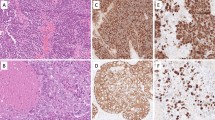Abstract
Atypical teratoid/rhabdoid tumor (AT/RT) is a rare, highly malignant tumor of the central nervous system (CNS) that typically occurs during infancy. These tumors exhibit morphologic heterogeneity and differentiate along multiple lineages, thus posing a diagnostic challenge. Here, we present two cases of AT/RT with a primitive neuroectodermal component and histological pattern resembling an embryonal tumor with multilayered rosettes (ETMR), a rare but distinctive embryonal entity with different therapeutic implications. Patient 1, a 23-month-old girl, presented with a history of gait unsteadiness and headache; cranial computed tomography (CT) identified a mass in the pineal and third ventricular regions. Patient 2, a 26-month-old girl, presented with headache and vomiting; CT revealed a mass in the posterior third ventricle. Both patients were treated via gross total tumor resection. Although histologically, AT/RT cases variably comprise primitive neuroectodermal, mesenchymal, and classic rhabdoid cells, the most striking feature of both cases was the presence of multilayered rosettes with a few Homer Wright rosettes and occasional primitive neuroepithelial tubes in focal primitive component areas. Immunohistochemistry revealed considerable heterogeneity within the tumors. We further present our findings in the context of the relevant literature.



Similar content being viewed by others
References
Rorke LB, Packer RJ, Biegel JA (1996) Central nervous system atypical teratoid/rhabdoid tumors of infancy and childhood: definition of an entity. J Neurosurg 85:5665
Eberhart CG, Brat DJ, Cohen KJ et al (2000) Pediatric neuroblastic brain tumors containing abundant neuropil and true rosettes. Pediatr Dev Pathol 3:346–352
Pfister S, Remke M, Castoldi M et al (2009) Novel genomic amplification targeting the microRNA cluster at 19q13.42 in a pediatric embryonal tumor with abundant neuropil and true rosettes. Acta Neuropathol 117:457–464
Korshunov A, Remke M, Gessi M et al (2010) Focal genomic amplification at 19q13.42 comprises a powerful diagnostic marker for embryonal tumors with ependymoblastic rosettes. Acta Neuropathol 120:253–260
Giangaspero F, Eberhart CG, Haapasalo H et al (2007) Central nervous system primitive neuroectodermal tumors. In: Louis DN, Ohgaki H, Wiestler OD, Cavenee WK (eds) WHO classification of tumours of the central nervous system. International Agency for Research on Cancer, Lyon, pp 141–146
Slavc I, Chocholous M, Leiss U et al (2014) Atypical teratoid rhabdoid tumor: improved long-term survival with an intensive multimodal therapy and delayed radiotherapy. The Medical University of Vienna Experience 1992–2012. Cancer Med 3:91–100
Spence T, Sin Chan P, Picard D (2014) CNS-PNETs with C19MC amplification and/or LIN28 expression comprise a distinct histogenetic diagnostic and therapeutic entity. Acta Neuropathol 128:291–303
Korshunov A, Ryzhova M, Jones D et al (2012) LIN28A immunoreactivity is a potent diagnostic marker of embryonal tumor with multilayered rosettes (ETMR). Acta Neuropathol 124:875–881
Packer RJ, Biegel JA, Blaney S et al (2002) Atypical teratoid/rhabdoid tumor of the central nervous system: report on workshop. J Pediatr Hematol Oncol 24:337–342
Rosai J (2004) Rosai and Ackeman’s surgical pathology, 9th edn. Mosby, St. Louis, pp 2560–2561
Hilden JM, Meerbaum S, Burger P et al (2004) Central nervous system atypical teratoid/rhabdoid tumor: results of therapy in children enrolled in a registry. J Clin Oncol 22:2877–2884
Dufour C, Beaugrand A, Le Deley MC et al (2012) Clinicopathologic prognostic factors in childhood atypical teratoid and rhabdoid tumor of the central nervous system. Cancer 118:3812–3821
Judkins AR, Ellison DW (2010) Ependymoblastoma: dear damned, distracting diagnosis, farewell! Brain Pathol 20:133–139
Nobusawa S, Yokoo H, Hirato J (2012) Analysis of chromosome 19q13.42 amplification in embryonal brain tumors with ependymoblastic multilayered rosettes. Brain Pathol 22:689–697
Deisch J, Raisanen J, Rakheja D (2011) Immunohistochemical expression of embryonic stem cell markers in malignant rhabdoid tumors. Pediatr Dev Pathol 14:353–359
Biegel JA, Zhou JY, Rorke LB et al (1999) Germ-line and acquired mutations of INI1 in atypical teratoid and rhabdoid tumors. Cancer Res 59:74–79
Viswanathan SR, Powers JT, Einhorn W, Hoshida Y (2009) Lin28 promotes transformation and is associated with advanced human malignancies. Nat Genet 41:843–848
Weingart MF, Roth JJ, Hutt-Cabezas M, Busse TM, Kaur H (2015) Disrupting LIN28 in atypical teratoid rhabdoid tumors reveals the importance of the mitogen activated protein kinase pathway as a therapeutic target. Oncotarget 20:3165–3177
Seno T, Kawaguchi T, Yamahara T, Sakurai Y (2008) An immunohistochemical and electron microscopic study of atypical teratoid/rhabdoid tumor. Brain Tumor Pathol 25:79–83
Li M, Lee KF, Lu Y (2009) Frequent amplification of a chr19q13.41 microRNA polycistronin aggressive primitive neuroectodermal brain tumors. Cancer Cell 16:533–546
Gessi M, Pfister S, Hans VH, Korshunov A, Pietsch T (2011) Absence of chromosome 19q13.41 amplification in a case of atypical teratoid/rhabdoid tumor with ependymoblastic differentiation. Acta Neuropathol 121:283–285
Acknowledgments
We thank Dr. Gehong Dong (Beijing Tongren Hospital, Capital Medical University) for her excellent technical assistance with fluorescence in situ hybridization.
Author information
Authors and Affiliations
Corresponding author
Ethics declarations
Funding
Funding for this study was provided by Grant Numbers 2013BAI09B03 from the National Key Technology Research and Development Program of the Ministry of Science and Technology of China, and BIBD-PXM2013_014226_07_000084 from the Beijing Institute for Brain Disorders.
Conflict of interest
The authors declare that they have no conflicts of interest.
Rights and permissions
About this article
Cite this article
Wang, J., Liu, Z., Fang, J. et al. Atypical teratoid/rhabdoid tumors with multilayered rosettes in the pineal region. Brain Tumor Pathol 33, 261–266 (2016). https://doi.org/10.1007/s10014-016-0267-3
Received:
Accepted:
Published:
Issue Date:
DOI: https://doi.org/10.1007/s10014-016-0267-3




